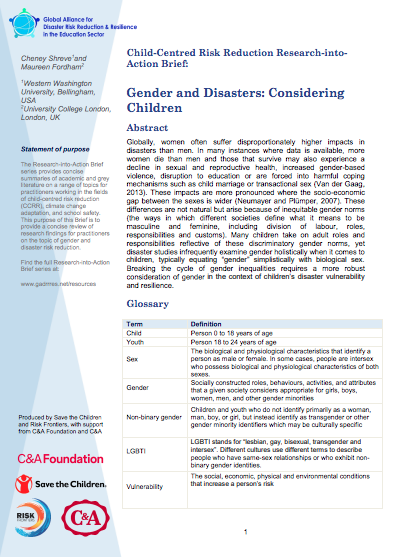
Research-into-Action Brief: Gender and Disasters – Considering Children
Publication year:
2018
English
Format:
pdf (288.1 KiB)
Publisher:
GADRRRES, Global Alliance for Disaster Risk Reduction and Resilience in the Education Sector
This brief explores how globally, women often suffer disproportionately higher impacts in disasters than men. In many instances where data is available, more women are shown to die compared to men and those that survive may also experience a decline in sexual and reproductive health, increased gender-based violence, disruption to education or are forced into harmful coping mechanisms such as child marriage or transactional sex. These impacts are more pronounced where the socio-economic gap between the sexes is wider. These differences are not natural but arise because of inequitable gender norms (the ways in which different societies define what it means to be a man and to be a woman, including division of labour, roles, responsibilities and customs). Many children take on adult roles and responsibilities reflective of these discriminatory gender norms, yet disaster studies infrequently examine gender holistically when it comes to children, typically equating “gender” simplistically with biological sex. Breaking the cycle of gender inequalities requires a more robust consideration of gender in the context of children’s disaster vulnerability and resilience. This brief is part of a series.
The Research-into-Action Brief series includes two main tools:
1. Research-into-Action Briefs and Summaries
2. Shared Bibliography on Zotero: https://www.zotero.org/groups/1857446/ccrr__css
These tools are for practitioners working in fields of child-centred risk reduction (CCRR), climate change adaptation (CCA) and school safety. The briefs and summaries are also intended to be used for training and capacity development for practitioners and partners, including government.
The briefs provide a concise review of research findings on a range of topics which have been selected by practitioners. The briefs have a focus on how the research findings could be (or have been) applied in practice. Each brief is 6-10 pages long, and generally contains a glossary, literature review, case study or examples, practical applications, key readings, and follow-up questions.
The summaries are two pages long and provide a quick snapshot of the main messages from the briefs. These can be used to both promote the full Research-into-Action Brief, to provide a quick overview of the topic, or to promote the use of research.
Read full abstract
Authors
View & Download
Document information
Publisher
Authors
Format
Rights
© Author/Publisher
Found a mistake? Help us improve!
If you have noticed a document assigned to the wrong author or any other inaccuracies, let us know! Your feedback helps us keep our data accurate and useful for everyone.
Share
Link
